The Effectiveness of Tannin on the Amount of Damage to Forest Trees and Stands Caused by Red Deer in the Western Carpathians
Abstract
1. Introduction
2. Materials and Methods
2.1. Study Areas
2.2. Sampling and Measurement
2.3. Applied Treatment
2.4. Statistical Analysis
3. Results
4. Discussion
5. Conclusions
Author Contributions
Funding
Data Availability Statement
Acknowledgments
Conflicts of Interest
Appendix A
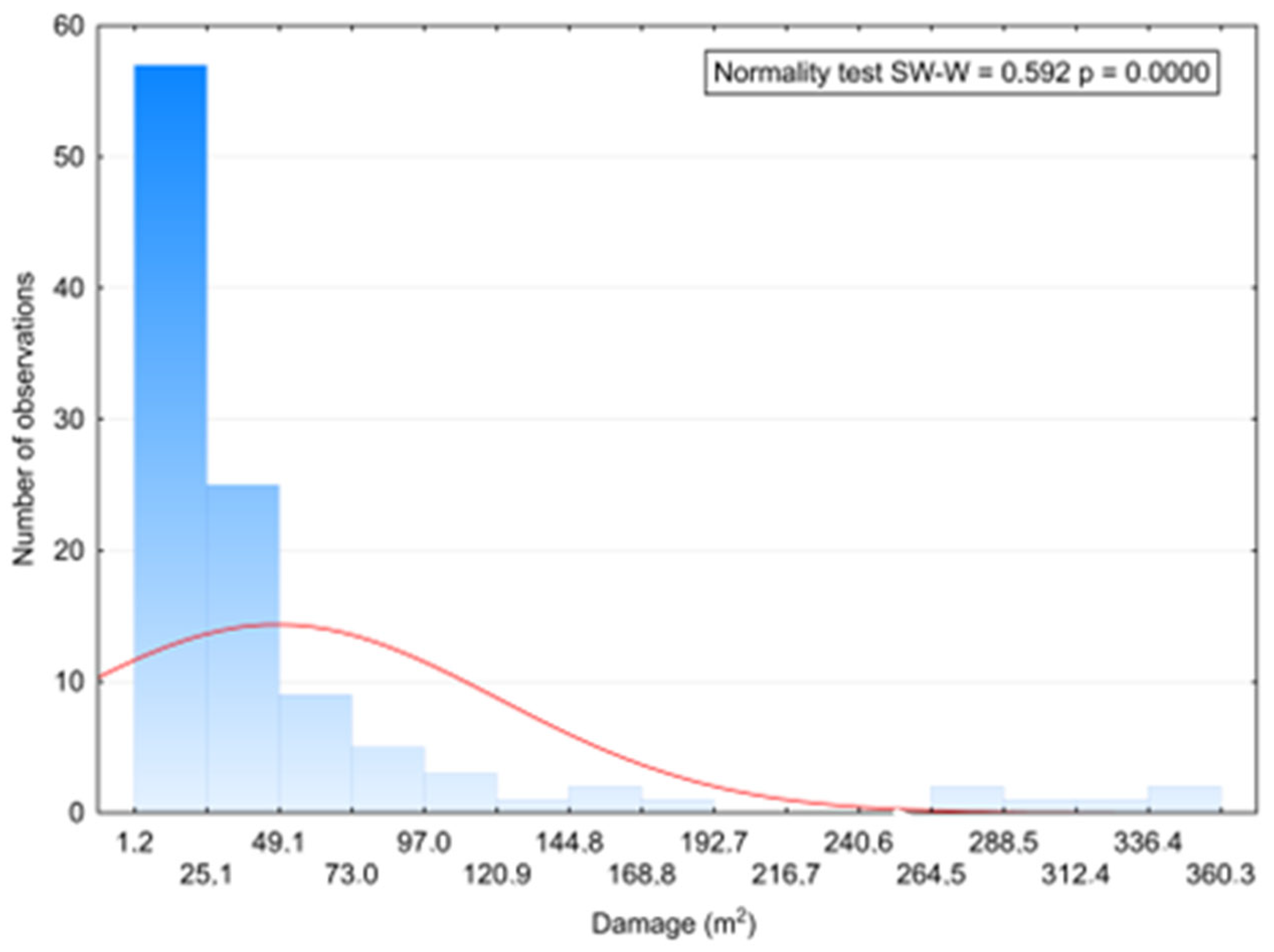
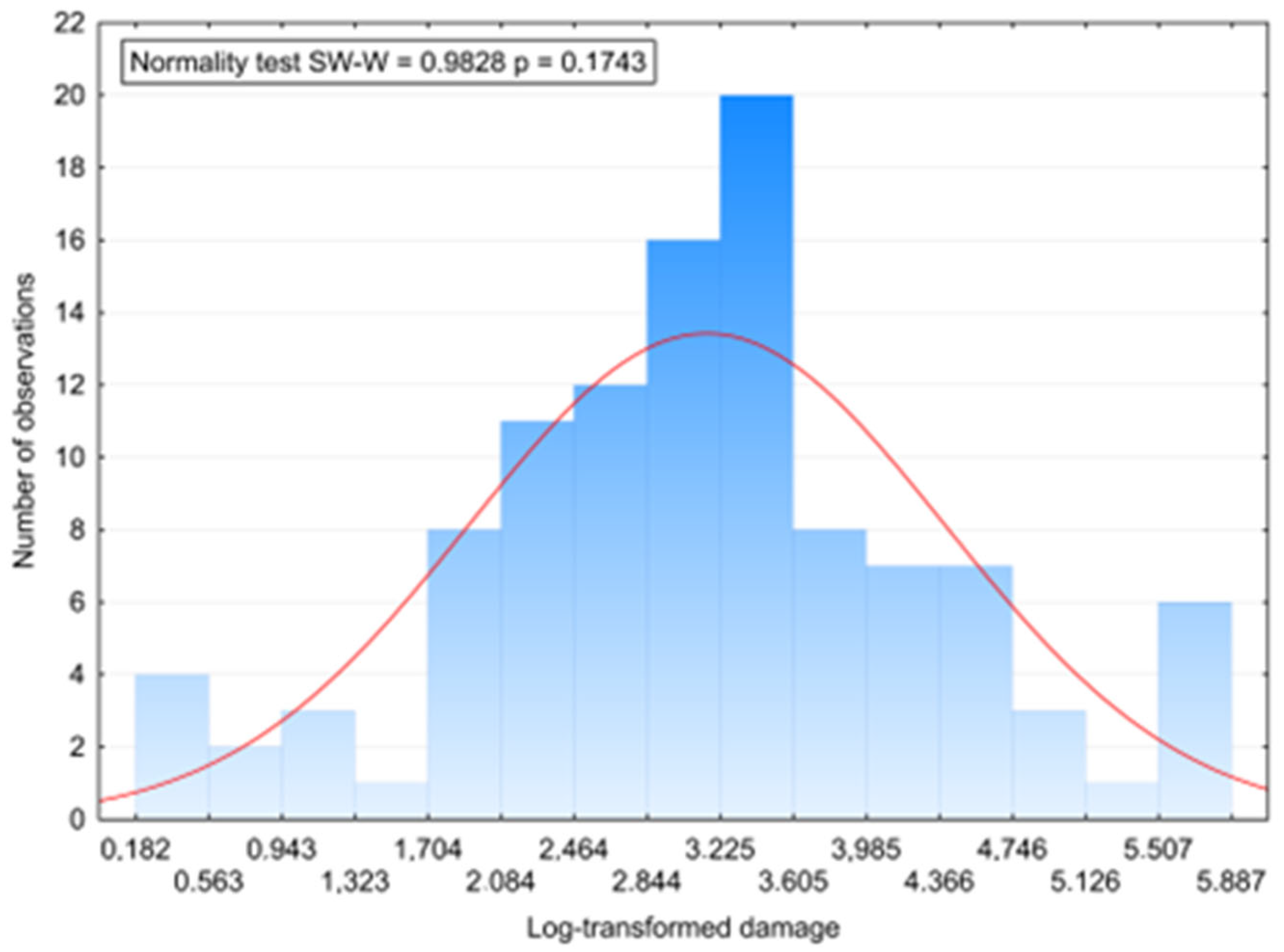
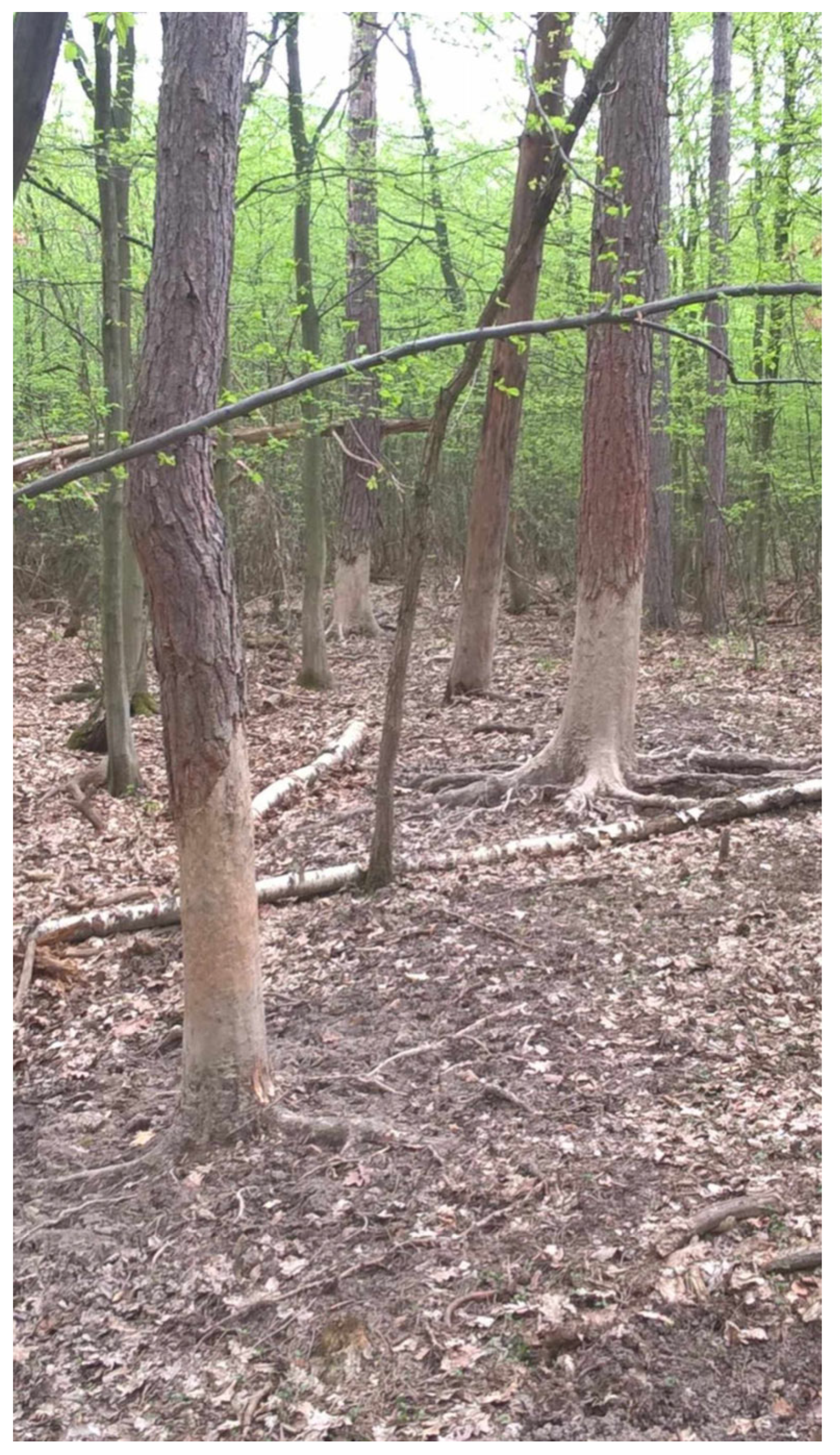

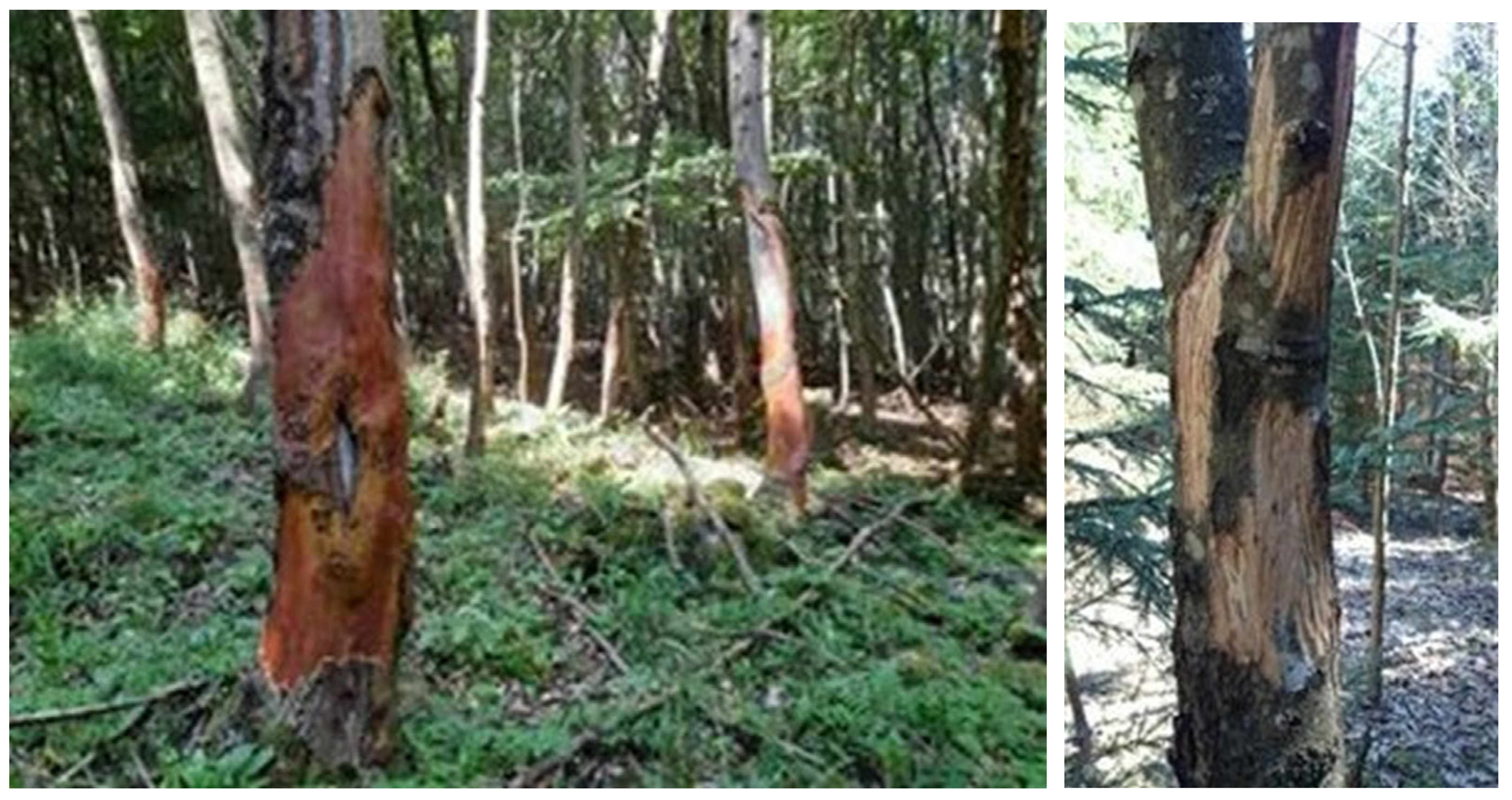
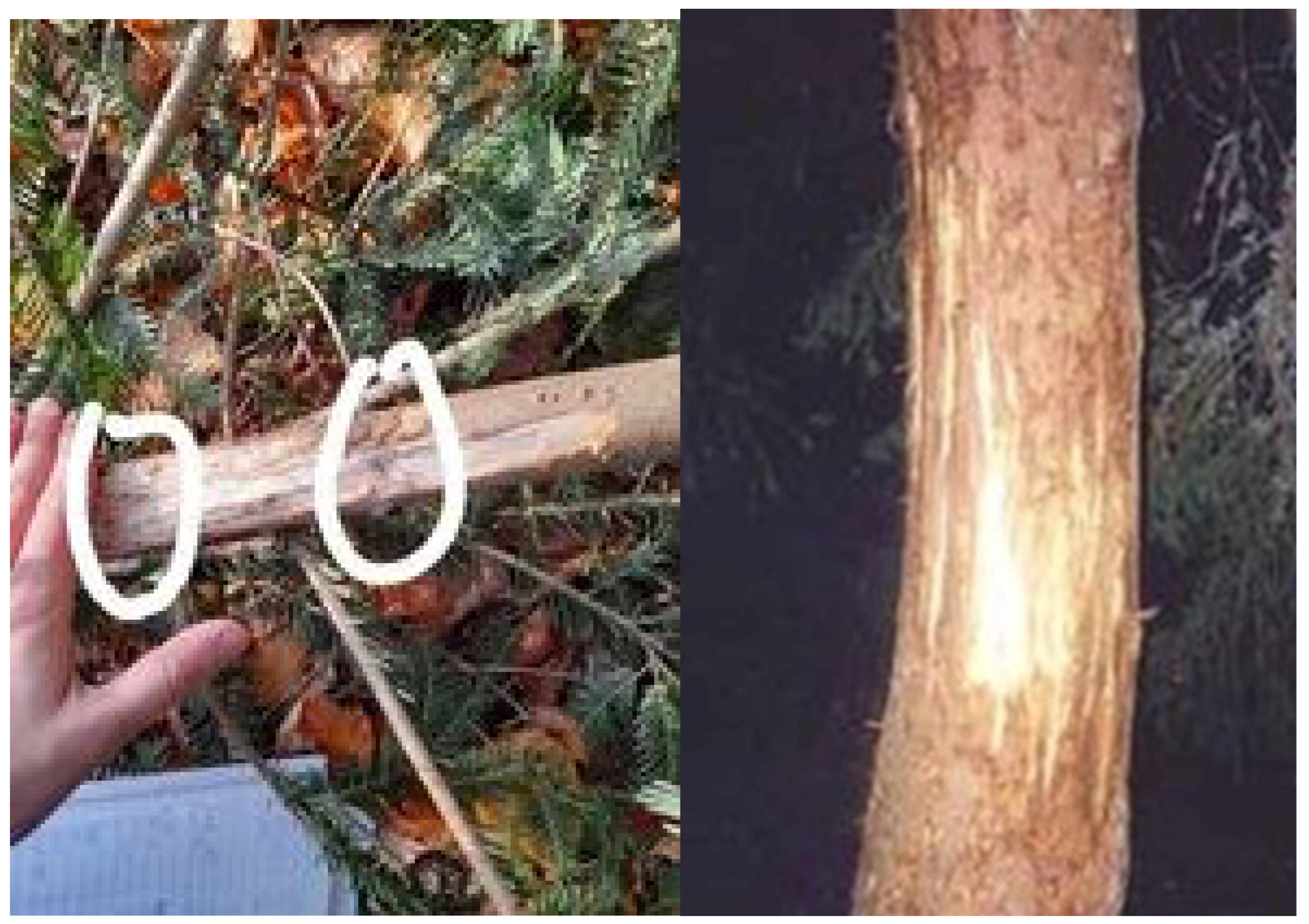
References
- Sicard, P.; Augustaitis, A.; Belyazid, S.; Calfapietra, C.; Marco, A.; Fenn, M.; Bytnerowicz, A.; Grulke, N.; He, S.; Matyssek, R.; et al. Global topics and novel approaches in the study of air pollution, climate change, and forest ecosystems. Environ. Pollut. 2016, 213, 977–987. [Google Scholar] [CrossRef]
- Kropil, R.; Garaj, P.; Smolko, P. Home range and migration patterns of male red deer Cervus elaphus in western Carpathians. Eur. J. Wildl. Res. 2015, 61, 63–72. [Google Scholar] [CrossRef]
- Heydon, M.J.; Wilson, C.J.; Tew, T. Wildlife conflict resolution: A review of problems, solutions and regulation in England. Wildl. Res. 2010, 37, 731–748. [Google Scholar] [CrossRef]
- Gren, I.M.; Häggmark-Svensson, T.; Elofsson, K.; Engelmann, M. Economics of wildlife management—An overview. Eur. J. Wildl. Res. 2018, 64, 22. [Google Scholar] [CrossRef]
- Jackson, A.L. Conserving Europe’s Wildlife: Law and Policy of the Natura 2000 Network of Protected Areas; Routledge: London, UK, 2018. [Google Scholar]
- Forbes, E.S.; Cushman, J.H.; Burkepile, D.E.; Young, T.P.; Klope, M.; Young, H.S. Synthesizing the effects of large, wild herbivore exclusion on ecosystem function. Funct. Ecol. 2018, 33, 1597–1610. [Google Scholar] [CrossRef]
- Valente, A.M.; Acevedo, P.; Figueiredo, A.M.; Fonseca, C.; Torres, R.T. Overabundant wild ungulate populations in Europe: Management with consideration of socio-ecological consequences. Mammal Rev. 2020, 50, 353–366. [Google Scholar] [CrossRef]
- Konôpka, B.; Šebeň, V.; Pajtík, J. What Amount of Bark Could Be Browsed by Game in a Forest Stand? The Example from the Husárik Research-Demonstrative Area. APOL 2023, 4, 144–152. (In Slovak) [Google Scholar]
- Vospernik, S. Probability of bark stripping damage by red deer (Cervus elaphus) in Austria. Silva Fenn. 2006, 40, 589. [Google Scholar] [CrossRef][Green Version]
- Candeale, R.; Lejeune, P.; Licoppe, A.; Malengreaux, C.; Brostaux, Y.; Morelle, K.; Latte, N. Mitigation of bark stripping on spruce: The need for red deer population control. Eur. J. For. Res. 2021, 140, 227–240. [Google Scholar] [CrossRef]
- Finďo, S.; Petráš, R. Ecological Foundations of Forest Protection Against Wildlife Damage; Národné Lesnícke Centrum, Lesnícky Výskumný Ústav: Zvolen, Slovakia, 2007; p. 186. ISBN 978-80-8093-034-9. (In Slovak) [Google Scholar]
- Månsson, J.; Jarmemo, A. Bark-stripping on Norway spruce by red deer in Sweden: Level of damage and relation to tree characteristics. Scand. J. For. Res. 2012, 28, 117–125. [Google Scholar] [CrossRef]
- Hahn, C.; Vospernik, S. Position, size, and spatial patterns of bark stripping wounds inflicted by red deer (Cervus elavus L.) on Norway spruce using generalized additive models in Austria. Ann. For. Sci. 2022, 79, 13. [Google Scholar] [CrossRef]
- Finďo, S. Options for Protecting Older Forest Stands Against Damage by Wildlife. In Current Issues in Forest Protection 2003, Proceedings of the Seminar, Zvolen, Slovakia, 19 October 2003; Varínsky, J., Ed.; NLC, LOS: Banská Štiavnica, Slovakia, 2003; pp. 149–153. (In Slovak) [Google Scholar]
- Cukor, J.; Vacek, Z.; Linda, R.; Vacek, S.; Marada, P.; Šimůnek, V.; Havránek, F. Effects of Bark Stripping on Timber Production and Structure of Norway Spruce Forests in Relation to Climatic Factors. Forests 2019, 10, 320. [Google Scholar] [CrossRef]
- Smolko, P.; Veselovská, A.; Kropil, R. Seasonal dynamics of forage for red deer in temperate forests: The importance of the habitat properties, stand development stage and overstorey dynamics. Wildl. Biol. 2018, 2018, 1–10. [Google Scholar] [CrossRef]
- Smolko, P.; Kropil, R.; Pataky, T.; Veselovská, A.; Merrill, E. Why do migrants move downhill? The effects of increasing predation and density on red deer altitudinal migration in temperate Carpathian forests. Mammal Res. 2018, 63, 297–305. [Google Scholar] [CrossRef]
- Barry, T.N.; Manley, T.R. Interrelationships between the concentrations of total condensed tannin, free condensed tannin, and lignin in Lotus sp. and their possible consequences in ruminant nutrition. J. Sci. Food Agric. 1986, 37, 248–254. [Google Scholar] [CrossRef]
- Mendel, M.; Chłopecka, M.; Dziekan, N.; Karlik, W. Phytogenic feed additives as potential gut contractility modifiers—A review. Anim. Feed Sci. Technol. 2017, 230, 30–46. [Google Scholar] [CrossRef]
- IBULH (Informatics Database on Forestry, Wood Processing Industry, and Hunting), 2024: Hunting Statistics. National Forest Centre Zvolen—Institute of Forest Resources and Informatics. 2024. Available online: https://gis.nlcsk.org/ibulh (accessed on 30 May 2024).
- Bučko, J.; Šuleková, D.; Gubka, A.; Slamka, M. Development of Abundance and Damage Caused by Ungulate According to the Outputs of the Hunting Statistical Yearbook of the Slovak Republic. APOL 2023, 4, 129–139. (In Slovak) [Google Scholar]
- Priesol, A. Tree Spacing; Vyd. SAV: Bratislava, Slovakia, 1978; p. 183. (In Slovak) [Google Scholar]
- Hoste, H.; Jackson, F.; Athanasiadou, A.; Thamvborq, S.M.; Hoskin, S.O. The effects of tannin-rich plants on parasitic nematodes in ruminants. Trends Parasitol. 2006, 22, 253–261. [Google Scholar] [CrossRef] [PubMed]
- Baková, K.; Slámka, M. Diet Composition of Red Deer in Winter. In Forest Protection Against Damage by Wildlife and Other Harmful Agents; Gubka, A., Ed.; NLC-LVÚ: Zvolen, Slovakia, 2018; pp. 21–26. ISBN 978-80-8093-249-7. (In Slovak) [Google Scholar]
- Stolina, M. Forest Protection; Príroda: Bratislava, Slovakia, 1985; 480p. (In Slovak) [Google Scholar]
- Finďo, S.; Maľová, M.; Longauerová, V. Use of the Biopreparation Repelak Against Forest Damage by Wildlife. In Forest Protection Against Damage by Wildlife and Other Harmful Agents; Gubka, A., Ed.; NLC-LVÚ: Zvolen, Slovakia, 2018; pp. 21–26. ISBN 978-80-8093-249-7. (In Slovak) [Google Scholar]
- Malík, V.; Karnet, P. Annual Shoots and Tree Bark As an Alternative Source of Feeding for the Cloven-Hoofed Game. (In Czech Language). Zprávy Lesnického Výzkumu, Roč. 54, č. 2, 2009, pp. 134–139. Available online: https://www.vulhm.cz/files/uploads/2019/01/150.pdf (accessed on 30 May 2024).
- Moore, B.D.; Foley, W.J.; Wallis, I.R.; Cowling, A.; Handasyde, K.A. Eucalyptus foliar chemistry explains selective feeding by koalas. Biol. Lett. 2005, 1, 64–67. [Google Scholar] [CrossRef]
- Foley, W.J.; Moore, B.D. Plant secondary metabolites and vertebrate herbivores—From physiological regulation to ecosystem function. Curr. Opin. Plant Biol. 2005, 8, 430–435. [Google Scholar] [CrossRef] [PubMed]
- Maertens, L.; Štruklec, M. Technical Note: Preliminary results with a tannin extract on the performance and mortality of growing rabbits in an enteropathy-infected environment. World Rabbit Sci. 2006, 14, 189–192. [Google Scholar] [CrossRef][Green Version]
- Min, B.R.; Pinchak, W.E.; Merkel, R.; Walker, S.; Tomita, G.; Anderson, R.C. Comparative antimicrobial activity of tannin extracts from perennial plants on mastitis pathogens. Acad. J. 2008, 3, 66–73. [Google Scholar]
- Prodanović, R.; Nedić, S.; Simeunović, P.; Borozan, S.; Nedić, S.; Bojkovski, J.; Kirovski, D.; Vujanac, I. Effects of chestnut tannins supplementation of prepartum moderate yielding dairy cows on metabolic health, antioxidant and colostrum indices. Ann. Anim. Sci. 2020, 21, 609–621. [Google Scholar] [CrossRef]
- Addisu, S. Effect of dietary tannin source feeds on Ruminal fermentation and production of cattle; a review. J. Anim. Feed Res. 2016, 6, 45–56. [Google Scholar]
- Latham, J.; Staines, B.W.; Gorman, M.L. Comparative feeding ecology of red (Cervus elaphus) and roe deer (Capreolus capreolus) in Scottish plantation forests. J. Zool. 1999, 247, 409–418. [Google Scholar] [CrossRef]
- Jerina, K. Roads and supplemental feeding affect the home-range size of Slovenian red deer more than natural factors. J. Mammal. 2012, 93, 1139–1148. [Google Scholar] [CrossRef]
- Robbins, C.T.; Hanley, T.A.; Hagerman, A.E.; Hjeljord, O.; Baker, D.L.; Schwartz, C.C.; Mautz, W.W. Role of Tannins in Defending Plants Against Ruminants: Reduction in Protein Availability. Ecol. Ecol. Soc. Am. 1987, 68, 98–107. [Google Scholar] [CrossRef]
- Robbins, C.T.; Mole, S.; Hagerman, A.E.; Hanley, T.A. Role of Tannins in Defending Plants Against Ruminants: Reduction in Dry Matter Digestion? Ecol. Ecol. Soc. Am. 1987, 68, 1606–1615. [Google Scholar] [CrossRef]
- Frutos, P.; Hervás, G.; Giráldez, F.J.; Mantecón, A.R. An in vitro study on the ability of polyethylene glycol to inhibit the effect of quebracho tannins and tannic acid on rumen fermentation in sheep, goats, cows, and deer. Aust. J. Agric. Res. 2004, 55, 1125–1132. [Google Scholar] [CrossRef]
- Toral, P.G.; Hervás, G.; Bichi, E.; Belenguer, A.; Frutos, P. Tannins as feed additives to modulate ruminal biohydrogenation: Effects on animal performance, milk fatty acid composition and ruminal fermentation in dairy ewes fed a diet containing sunflower oil. Anim. 2011, 164, 199–206. [Google Scholar] [CrossRef]
- Verheyden-Tixier, H.; Renaud, P.C.; Morellet, N.; Jamot, J.; Besle, J.M.; Dumont, B. Selection for nutrients by red deer hinds feeding on a mixed forest edge. Oecologia 2008, 156, 715–726. [Google Scholar] [CrossRef] [PubMed]
- Chapman, G.A.; Bork EW Donkor, N.T.; Hudson, R.J. Effects of supplemental dietary tannins on the performance of white-tailed deer (Odocoileus virginianus). J. Anim. Physiol. Anim. Nutr. 2010, 94, 65–73. [Google Scholar] [CrossRef] [PubMed]
- Jones, P.D.; Rude, B.; Muir, J.M.; Demarais, S.; Strickland, B.K.; Scott LEdwards, S.L. Condensed Tannins’ Effect on White-Tailed Deer Forage Digestibility in Mississippi. J. Wildl. Manag. 2010, 74, 707–713. [Google Scholar] [CrossRef]
- Krueger, W.K.; Gurierrez- Bañuelos, J.; Carstens, G.E.; Min, B.R.; Pinchak, W.E.; Gomez, R.R.; Anderson, R.C.; Krueger, N.A. Forbes Effects of dietary tannin source on performance, feed efficiency, ruminal fermentation, and carcass and non-carcass traits in steers fed a high-grain diet. Anim. Feed. 2010, 159, 1–9. [Google Scholar] [CrossRef]
- Tong, Z.; Wenfeng, H.; Xiao, A.O. Biological Function of Plant Tannin and Its Application in Animal Health. Front. Vet. Sci. 2021, 8, 803657. [Google Scholar] [CrossRef]
- Milner, J.M.; van Beest, F.M.; Schmidt, K.T.; Brook, R.K.; Storaas, T. To feed or not to feed? Evidence of the intended and unintended effects of feeding wild ungulates. J. Wildl. Manag. 2014, 78, 1322–1334. [Google Scholar] [CrossRef]
- Zweifel-Schielly, B.; Leuenberger, Y.; Kreuzer, M.; WSuter, W. A herbivore’s food landscape: Seasonal dynamics and nutritional implications of diet selection by a red deer population in contrasting Alpine habitats. J. Zool. 2012, 286, 68–80. [Google Scholar] [CrossRef]
- Turchi, B.; Mancini, S.; Pastorelli, R.; Viti, C.; Tronconi, L.; Bertelloni, F.; Felicioli, A.; Cerri, D.; Fratini, F.; Paci, G. Dietary supplementation of chestnut and quebracho tannins mix: Effect on caecal microbial communities and live performance of growing rabbits. Res. Vet. Sci. 2019, 124, 129–136. [Google Scholar] [CrossRef]
- Nawab, A.; Tang, S.; Gao, W.; Li, G.; Xiao, M.; An, L.; Wu, J.; Liu, W. Tannin Supplementation in Animal Feeding; Mitigation Strategies to Overcome the Toxic Effects of Tannins on Animal Health: A Review. J. Agric. Sci. 2020, 12, 217. [Google Scholar] [CrossRef]
- Waghorn, G. Beneficial and detrimental effects of dietary condensed tannins for sustainable sheep and goat production—Progress and challenges. Anim. Feed Sci. Technol. 2008, 147, 116–139. [Google Scholar] [CrossRef]
- Kumar, R.; Vaithiyanathan, S. Occurrence, nutritional significance and effect on animal productivity of tannins in tree leaves. Anim. Feed Sci. Technol. 1990, 30, 21–38. [Google Scholar] [CrossRef]
- Hernández, P.R.; Palomo, C.R.; Fernández, S.S.; Moya PJ, R.; Zafra, R.; Moreno FJ, M.; Estévez, V.R.; Díaz-Gaona, C. Antiparasitic Tannin-Rich Plants from the South of Europe for Grazing Livestock: A Review. Animals 2023, 13, 201. [Google Scholar] [CrossRef]
- Saric, T.; Rogosic, J.; Zupan, I.; Beck, R.; Bosnic, S.; Sikic, Z.; Skobic, D.; Tkalcic, S. Anthelmintic effect of three tannin-rich Mediterranean shrubs in naturally infected sheep. Small Rumin. Res. 2015, 123, 179–182. [Google Scholar] [CrossRef]

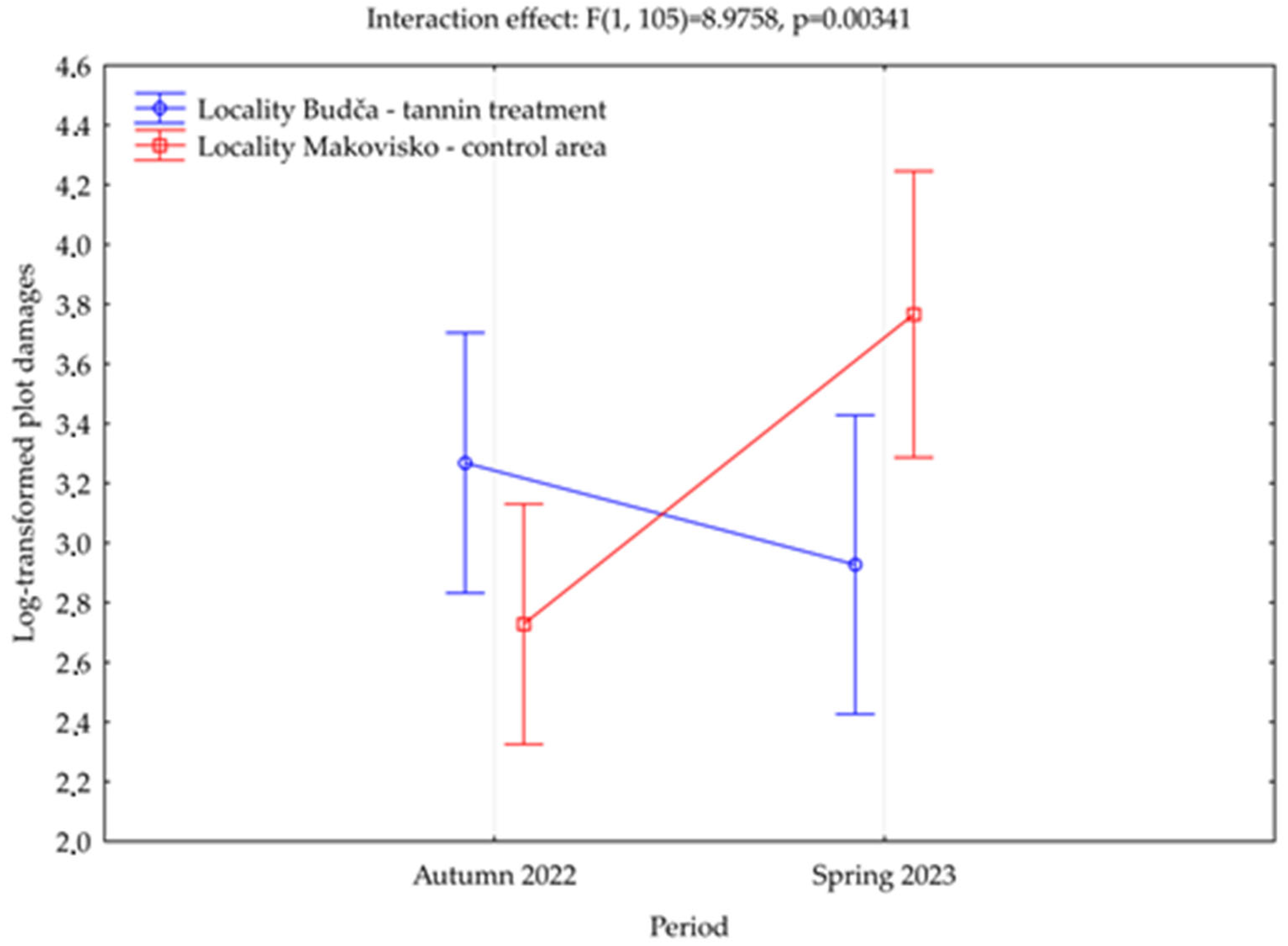
| Budča | Makovisko | ||||||
|---|---|---|---|---|---|---|---|
| Stand | Area [ha] | Age * | Tree Species | Stand Number | Area [ha] | Age * | Tree Species |
| 407 | 7.1 | 5-15-35 | Fs, Aa, Pa, Cb, Aps | 153 | 14.9 | 10-20-40 | Fs, Pa, Fe, Aps, Ld |
| 408 | 9.08 | 5-25-35-170 | Fs, Pa, Qp, Aa, Ld, Aps | 154 | 12.41 | 20-35-160 | Fs, Fe, Pa, Aps, Ld |
| 409 | 17.38 | 5-10-15-25-40-170 | Fs, Aa, Tc, Cb, Aps, Apl, Pa, Ld | 155a | 15.85 | 20-40-145 | Fs, Tc, Um, Apl, Pa, Ld |
| 410 | 13 | 5-15-40-60 | Fs, Aa, Tc, Cb, Apl, Fe | 155b | 0.55 | 60 | Fs |
| 412a | 8.13 | 5-20-35 | Fs, Aa, Ld, Qp, Pa, Cb | 156 | 17.67 | 15-25-35-150 | Fs, Pa, Aps, Fe, Ld |
| 413 | 7.88 | 5-30-125 | Fs, Cb, Aa, Qp, Aps, Pav, Fe | 157 | 14.62 | 5-15-20-30-40-150 | Fs, Pa, Ld, Fe |
| 518a | 12.57 | 5-15-35-150 | Fs, Pa, Aa, Aps, Qp | 158 | 12.79 | 10-15-30-130 | Fs, Pa, Ld |
| 519 | 7.89 | 40-110 | Fs, Pa, Ld, Aps, Aa | 159 | 14.3 | 30-135 | Fs, Pa, Ld |
| 520 | 8.03 | 5-30 | Fs, Pa, Aa, Ld | 160a | 11.94 | 10-30-40-155 | Fs, Pa, Aps, Ld, Bp |
| 522 | 11.42 | 10-35-160 | Fs, Pa, Aa, Aps, | 160b | 1.69 | 60 | Fs |
| 523 | 7.49 | 30 | Fs, Pa, Ld, Aa | 161a | 5.45 | 5-15-60-120 | Fs, Ld, Pa, Aps, Qp, Cb |
| 524a | 5.22 | 35 | Fs, Pa, Aa, Ld | 161b | 1.84 | 55 | Ag, Fs, Fe, Bp |
| 524b | 2.97 | 15 | Fs, Pa, Aps, Aa | 164a | 9.99 | 15 | Fs |
| 525 | 9.79 | 4-15-20-35-140 | Fs, Pa, Qp, Aps, Fe, Cb, Aa | 280a | 4.72 | 50-190 | Qp, Fs, Cb |
| 527b | 0.77 | 10 | Fs, Pa, Fe | 280c | 9.23 | 40 | Qp, Cb, Fs, Aps, Tc, Ld |
| 528a | 5.75 | 35-95 | Fs, Aa, Fe, Aps | - | - | - | - |
| 528b | 0.62 | 10 | Fs, Fe, Aps | - | - | - | - |
| Total | 135.09 | - | - | Total | 147.95 | - | - |
| Locality | Budča | Makovisko | ||
|---|---|---|---|---|
| Period | Autumn | Spring | Autumn | Spring |
| Number of plots (damaged/undamaged) | 29/40 | 22/47 | 34/37 | 24/47 |
| Mean damage per plot [m2ha−1] | 41.66 | 27.26 | 42.11 | 84.19 |
| The average size of the individual wound [m2] | 0.1204 | 0.0831 | 0.1236 | 0.2109 |
| Total damage per experimental area [m2] | 5627 | 3682 | 6230 | 12,456 |
| Parameter | SS | Degrees of Freedom | MS | F | p |
|---|---|---|---|---|---|
| Absolute value | 1066.18 | 1 | 1066.18 | 760.123 | 0.00000 |
| Location | 0.592 | 1 | 0.592 | 0.4224 | 0.51717 |
| Period | 3.22 | 1 | 3.22 | 2.2954 | 0.13276 |
| Location*Period | 12.59 | 1 | 12.59 | 8.9758 | 0.00341 |
| Error | 147.277 | 105 | 1.403 | - | - |
| Location | Period | {1}—3.2679 | {2}—2.9271 | {3}—2.7280 | {4}—3.7661 |
|---|---|---|---|---|---|
| Budča | Autumn | - | 0.77557 | 0.31062 | 0.46705 |
| Spring | 0.77557 | - | 0.94438 | 0.09364 | |
| Makovisko | Autumn | 0.310618 | 0.944375 | - | 0.01584 |
| Spring | 0.467052 | 0.093637 | 0.01584 | - |
Disclaimer/Publisher’s Note: The statements, opinions and data contained in all publications are solely those of the individual author(s) and contributor(s) and not of MDPI and/or the editor(s). MDPI and/or the editor(s) disclaim responsibility for any injury to people or property resulting from any ideas, methods, instructions or products referred to in the content. |
© 2024 by the authors. Licensee MDPI, Basel, Switzerland. This article is an open access article distributed under the terms and conditions of the Creative Commons Attribution (CC BY) license (https://creativecommons.org/licenses/by/4.0/).
Share and Cite
Štefanec, M.; Hlaváč, P.; Sedmák, R.; Lebocký, T.; Ivan, M.; Kropil, R. The Effectiveness of Tannin on the Amount of Damage to Forest Trees and Stands Caused by Red Deer in the Western Carpathians. Forests 2024, 15, 1499. https://doi.org/10.3390/f15091499
Štefanec M, Hlaváč P, Sedmák R, Lebocký T, Ivan M, Kropil R. The Effectiveness of Tannin on the Amount of Damage to Forest Trees and Stands Caused by Red Deer in the Western Carpathians. Forests. 2024; 15(9):1499. https://doi.org/10.3390/f15091499
Chicago/Turabian StyleŠtefanec, Marek, Pavol Hlaváč, Róbert Sedmák, Tibor Lebocký, Mojmír Ivan, and Rudolf Kropil. 2024. "The Effectiveness of Tannin on the Amount of Damage to Forest Trees and Stands Caused by Red Deer in the Western Carpathians" Forests 15, no. 9: 1499. https://doi.org/10.3390/f15091499
APA StyleŠtefanec, M., Hlaváč, P., Sedmák, R., Lebocký, T., Ivan, M., & Kropil, R. (2024). The Effectiveness of Tannin on the Amount of Damage to Forest Trees and Stands Caused by Red Deer in the Western Carpathians. Forests, 15(9), 1499. https://doi.org/10.3390/f15091499







